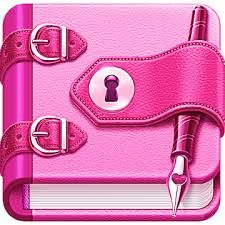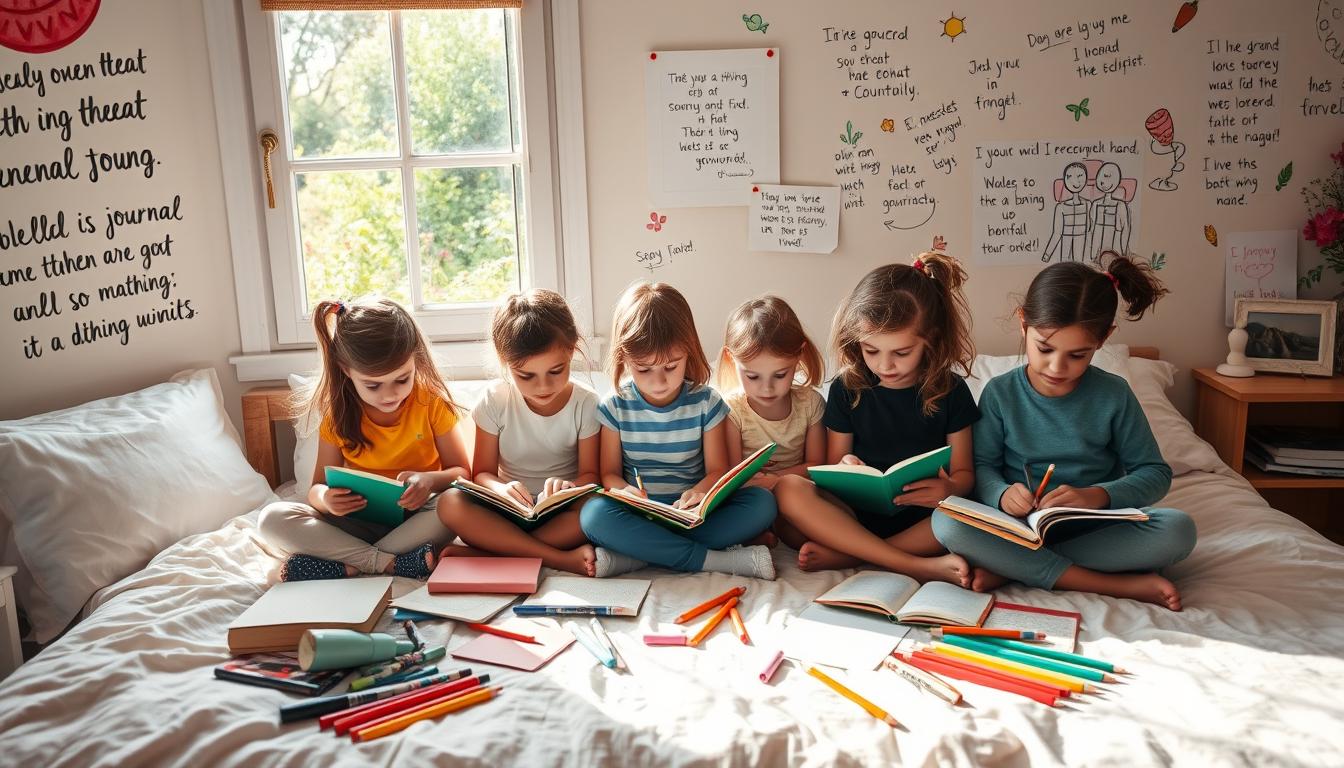Journaling offers kids and teens a safe space for self-discovery and healing. It’s more than just writing; it’s about understanding oneself and processing complex feelings. This practice helps young people create a personal roadmap for growth.
Modern journaling has evolved beyond traditional locked notebooks. It now embraces creativity, offering various ways for self-expression. Young people can use sketches, digital entries, or heartfelt writing as emotional outlets.
Studies reveal that 40% of teens use journaling to manage stress and anxiety. This isn’t just a hobby; it’s a vital tool for emotional well-being. As parents, supporting your child’s journaling can unlock opportunities for growth.
This guide explores how journaling can transform kids’ and teens’ lives. We’ll provide practical strategies and inspiration to encourage self-reflection and creativity. Let’s dive into this powerful practice together.
Benefits of Journaling for Kids and Teens
Journaling is a powerful tool for kids and teens. It helps them understand themselves better and manage their emotions. Research shows many benefits beyond just writing things down.
Regular journaling can greatly improve teens’ emotional health. It also helps with personal growth. Let’s look at the amazing benefits of this simple practice.
Enhancing Creativity and Self-Expression
Journaling gives young people a place to be creative. 90% of teens find journaling a safe way to express their thoughts and feelings. It allows them to explore ideas freely.
Through journaling, kids can develop unique storytelling skills. They can also try out different writing styles without fear of judgment.
- Explore their imagination without judgment
- Develop unique storytelling skills
- Experiment with different writing styles
Improving Writing Skills
Journaling helps students who struggle with writing. 65% of teens believe journaling helps improve their writing skills. It gives them regular practice.
This practice can boost vocabulary and communication skills. It can also lead to better grades in school.
- Enhance vocabulary
- Develop communication abilities
- Boost academic performance
Promoting Emotional Well-Being
Journaling is great for managing emotions and mental health. The numbers show how helpful it can be:
| Emotional Benefit | Percentage of Teens |
|---|---|
| Better emotional understanding | 77% |
| Increased emotional regulation | 85% |
| Reduced anxiety symptoms | 50% less likely |
| Stress management | 60% more effective |
“Journaling provides a safe, judgment-free space for children to address complicated emotions” – Mental Health Research
Journaling can really help kids with ADHD or learning challenges. It gives them a way to organize their thoughts. This can improve their focus and mental processes.
Getting Started with Journaling
Journaling can be a thrilling adventure for kids and teens. It turns a blank page into a canvas of self-discovery. The right approach sparks creativity and personal growth.
Choosing the Right Journal
Picking the perfect journal is key for engaging children. Different ages need unique approaches to journaling. The right choice can make all the difference.
- For younger children (3-7 years): Colorful notebooks with lined pages and space for drawings
- For tweens (8-12 years): Journals with fun themes or motivational quotes
- For teens (13-18 years): Sleek, minimalist designs or digital journaling apps
Creating a Comfortable Writing Space
A dedicated journaling spot can boost a child’s writing experience. Studies show half of school-age kids see journals as safe spaces. They can share thoughts without fear of judgment.
“A comfortable writing space is the first step to unlocking a child’s inner voice.”
Here are tips for setting up an inviting journaling area:
- Choose a quiet, well-lit location
- Provide comfortable seating
- Minimize digital distractions
- Keep writing supplies nearby
| Age Group | Recommended Journal Type | Writing Space Considerations |
|---|---|---|
| 3-7 years | Picture journals | Colorful, open area with art supplies |
| 8-12 years | Guided prompt journals | Quiet corner with good lighting |
| 13-18 years | Digital or personal notebooks | Private space with minimal interruptions |
Using age-appropriate prompts can make journaling more fun. Research shows 85% of kids who journal can express feelings better. Start with simple, fun prompts that spark imagination.
Different Types of Journals for Kids and Teens
Journaling offers unique ways for kids and teens to explore creativity and emotions. The right journal can turn writing into an exciting personal adventure. Each type provides different benefits for self-expression and growth.

Let’s explore some exciting diary ideas for teens and journaling approaches for kids. These can spark imagination and help with self-expression.
Gratitude Journals
Gratitude journals help young writers focus on positive experiences. Research shows that journaling about feelings improves emotional understanding. By writing down things they appreciate, children can boost their mood.
Kids who keep gratitude journals often develop better emotional intelligence. They may also experience less stress and anxiety in their daily lives.
- Develop a more positive mindset
- Improve emotional intelligence
- Reduce stress and anxiety
Dream Journals
A dream journal turns nighttime stories into creative writing opportunities. Kids can capture their subconscious imagination through various methods. These include sketching dream scenes and describing vivid details.
- Sketching dream scenes
- Describing vivid dream details
- Analyzing dream symbolism
Travel Journals
Travel journals make journaling an exciting adventure for kids. Studies show that 75% of parents notice improved observational skills in children who document trips.
These journals help kids preserve memories and practice descriptive writing. They also develop storytelling skills through their travel experiences.
- Preserve travel memories
- Practice descriptive writing
- Develop storytelling skills
Bullet Journals
Bullet journals are perfect for organized teens. They combine creativity and planning in a versatile way. This style allows young writers to track goals and create personalized layouts.
- Track goals and habits
- Create personalized layouts
- Mix writing with artistic expression
“Journaling is a powerful tool for self-discovery and creativity. There’s no right or wrong way to keep a journal.” – Child Psychology Expert
The best journal is one that matches your personal style and interests. Encourage your child to try different types. They’ll find what feels most enjoyable and meaningful to them.
Encouraging Consistent Writing Habits
Journaling can change how kids and teens express themselves. Many teens use prompts to inspire their writing. Age-appropriate prompts are key to keeping them engaged.

Building a lasting journaling habit takes strategy and patience. Your approach should be flexible and fun. Make it enjoyable for your child.
Setting a Routine
Consistency is more important than frequency. You don’t need to journal every day. Focus on creating a rhythm that suits your child.
- Choose a specific time of day
- Select a comfortable writing space
- Start with short 10-15 minute sessions
- Be flexible with the schedule
Using Prompts and Ideas
Age-appropriate prompts can spark creativity and beat writer’s block. They offer a starting point for self-expression. Prompts make journaling less scary for kids.
| Age Group | Journaling Prompt Examples |
|---|---|
| 6-9 years | What made you smile today? Draw your favorite moment. |
| 10-13 years | Describe a challenge you overcame this week. |
| 14-17 years | Reflect on a personal goal and your progress. |
“Writing is a powerful tool for understanding yourself and the world around you.” – Unknown
The goal is to make journaling positive and enriching. Your child should look forward to it, not see it as a chore.
Making Journaling Fun
Journaling can be an exciting adventure for kids and teens. It’s a journey of self-discovery and creativity. By turning diary ideas into engaging activities, journaling becomes a thrilling experience.

Unleashing Creativity with Art and Doodles
Journaling becomes magical when art joins the mix. Your journal can be more than just words. It can be a canvas for expression.
Try these fun approaches:
- Sketch alongside your written entries
- Use colorful stickers and washi tape
- Create collages from magazine cutouts
- Experiment with watercolor backgrounds
“Art is another language of expression that can help teens communicate feelings words sometimes can’t capture.”
Embracing Digital Journaling Tools
Tech-savvy kids can explore digital journaling platforms. These make writing interactive and fun. Many apps offer cool features.
- Customizable templates
- Password protection
- Multimedia integration
- Mood tracking features
Studies show that 70% of children feel happier after keeping a journal. Enjoyable journaling helps develop self-reflection and emotional intelligence.
Keep it light, personal, and judgment-free. Let your child’s creativity flow naturally!
Addressing Common Concerns
Journaling helps kids discover themselves. Parents worry about privacy and challenges. Understanding these concerns creates a supportive environment for young writers.
Kids can express themselves freely through journaling. It’s a great way for them to explore their thoughts and feelings.

Overcoming Writer’s Block
Writer’s block can scare young journalers. Help your child overcome this with creative strategies.
- Use engaging writing prompts
- Encourage freewriting without judgment
- Suggest alternative expression methods like drawing
- Create themed journaling challenges
“Writing is not about perfection, but about personal expression and growth.” – Child Development Expert
Encouraging Vulnerability
A safe space for emotional exploration is crucial in kids’ journaling. Writing about feelings can reduce anxiety and depression symptoms.
| Age Group | Mental Health Benefits | Journaling Impact |
|---|---|---|
| 6-11 years | Emotional processing | Develop self-awareness |
| 12-17 years | Stress management | Build coping strategies |
Protecting Privacy
Privacy concerns matter to both parents and children. Consider these approaches:
- Establish clear boundaries about journal privacy
- Use password-protected digital journals
- Discuss trust and respect
- Offer support without invasive questioning
Remember, the goal is to create a judgment-free zone where kids feel safe exploring their thoughts and emotions.
Tips for Parents to Support Their Young Writers
Parents play a key role in nurturing their children’s writing skills. They can do this through age-appropriate prompts and journaling for kids. Patience, creativity, and genuine interest are essential in this process.
Writing together can transform your relationship with your child. Studies show that 75% of kids are more likely to write when they see their parents enjoying it.

Leading by Example
Children learn best by watching others. Your own journaling practice shows the value of self-reflection and creative expression. Here are some helpful strategies:
- Journal together for 10-15 minutes a couple of times a week
- Share age-appropriate writing experiences
- Keep your personal journal private to respect boundaries
“Writing is a powerful tool for understanding ourselves and the world around us.” – Lucy Calkins
Asking Open-Ended Questions
Use thoughtful, non-invasive questions to spark your child’s writing. The aim is to inspire reflection without creating pressure. Here are three types of questions to try:
- Curiosity-driven questions about their day
- Imaginative prompts that spark creativity
- Emotional check-in questions
Kids are more motivated when they can choose their writing topics. Offer 5-7 different prompts to inspire them. This ensures a fun and pressure-free journaling experience for kids.
Sharing and Celebrating Their Work
Journaling isn’t just a private activity for kids and teens. Sharing their writing can boost confidence and create connections. It’s a powerful way to bond with family and friends.
Family Journaling Nights: Building Connections
Sharing journal entries can turn writing into a bonding experience. Families who practice gratitude journaling often see positive changes. These include stronger bonds and better emotional intelligence.
It also leads to more meaningful conversations among family members.
- Strengthened family bonds
- Improved emotional intelligence
- More meaningful conversations
“Sharing our thoughts can turn individual reflections into collective growth.”
Creating a Collection of Writings
Teens can compile their most meaningful entries into a special keepsake. This collection becomes a personal time capsule of growth and memories. It’s a great way to preserve their thoughts and experiences.
| Collection Type | Benefits |
|---|---|
| Physical Scrapbook | Tangible memories, creative expression |
| Digital Portfolio | Easy to update, shareable |
| Gratitude Journal Compilation | Tracks personal growth and positive moments |
When sharing writings, create a non-judgmental, supportive atmosphere. The goal is to celebrate creativity and self-expression. It’s not about critiquing the work.
- Encourage voluntary sharing
- Praise effort and vulnerability
- Respect personal boundaries
Resources and Tools for Journaling
The right resources can enhance your child’s journaling experience. Many digital platforms now offer specialized support for young writers. Age-appropriate prompts engage kids in meaningful writing activities that boost creativity and emotional understanding.
Keri Smith’s “Wreck This Journal” and Mindfulness Press offer interactive journals for imagination. Structured writing guides help focus attention for students with ADHD or learning challenges. Digital apps like WriteDiary, Journey and Penzu Kids provide safe platforms for young writers to explore thoughts.
Recommended Journals for Different Ages
Choosing the right journal is crucial. Younger children enjoy colorful journals with built-in prompts. Teens often prefer minimalist designs that feel more grown-up.
Journals with drawing spaces can increase engagement by 30%. These multimodal elements make writing more fun for creative minds.
Online Communities and Support
Online writing workshops connect young writers. Platforms like Write Shop and TeenInk offer spaces to share work and get feedback.
These digital communities enhance writing skills. They also create supportive networks for emotional expression and growth.
FAQ
At what age can my child start journaling?
Children can begin journaling as early as 5 or 6 years old. For younger kids, start with picture journals or simple prompts. These encourage drawing and basic writing. As they grow, they can move to more detailed written entries.
How can journaling help children with ADHD or learning difficulties?
Journaling helps kids with ADHD or learning difficulties organize thoughts and improve focus. It develops self-reflection skills and helps manage emotions. Structured prompts and creative approaches can boost their self-expression.
How do I protect my child’s privacy while supporting their journaling?
Respect your child’s privacy by setting clear boundaries. Don’t read their journal without permission. Create a safe space for them to write freely.
Consider using a journal with a lock or a digital app with privacy settings. Talk openly about trust and personal boundaries.
What if my child struggles with writing or doesn’t want to journal?
Make journaling fun and stress-free. Offer options like art journals, digital apps, or journals with creative prompts. Use stickers or drawing to make it more engaging.
Start with short, simple entries and build the habit slowly. Remember, the goal is self-expression, not perfect writing.
Are digital journaling apps safe for kids?
Choose age-appropriate apps with strong privacy settings and parental controls. Look for secure, ad-free apps with positive parent reviews. Discuss online safety with your child.
Monitor their digital journaling while respecting their privacy. This balance helps ensure a safe experience.
How often should my child journal?
There’s no strict rule for journaling frequency. Some kids enjoy daily entries, while others prefer weekly writing. Encourage a routine that fits your child’s schedule and interests.
The key is to make journaling enjoyable, not a chore. Keep it flexible and consistent for best results.
Can journaling help with my teenager’s emotional well-being?
Yes! Journaling is a powerful tool for teens to process emotions and reduce stress. It provides a private outlet for exploring feelings and working through challenges.
This practice helps develop self-awareness and track personal growth during the complex teen years.
What types of journals are best for different age groups?
Young children might enjoy gratitude journals or picture journals. Teens might prefer bullet journals for organization or reflective journals for emotional exploration.
Travel journals, dream journals, and art journals can appeal to various ages. The best journal matches your child’s personality and interests.
Source Links
- Journaling With Teens | MU Extension
- Finding Calm After the Storm: A Journaling Guide for Teens and Families – Child Mind Institute
- How journaling and journaling prompts can help kids and teens after abuse – Indiana Child Advocacy Centers and Chapter of NCA
- The Mental Health Benefits of Journaling for Teens | Tilly’s Life Center
- 5 Key Reasons to Encourage Your Child to Journal
- How to journal with your child to foster a deeper connection – Thriving Parents
- Connecting with Teens through Shared Journaling – Chosen Care
- Encourage Journaling for Kids Ages 4–14
- 13 Best Types of Journals for Kids
- 9 Unique Journals That Give Tweens and Teens a Place to Reflect and Grow | Brightly
- 57 Deep Journal Prompts for Personal Growth & Self-Improvement – Sage & Bloom
- 10 Ways Journaling Benefits Students | USAHS
- 80+ Journal Prompts for Kids for Creativity & Self-Discovery
- 52 Journal Prompts for Kids to Practice Writing – Waterford.org
- 150 Journal Prompts for Kids, Middle & High School Students
- Behaviour and how to handle it: pre-teens and teenagers
- How to help children and teens manage their stress
- How to Encourage Our Children to Write
- Helping Parents Understand Writing Workshop: Keep Learning Going Throughout the Summer
- 10 Ways to Nurture a Young Writer | Jane Friedman
- Here’s How to Start Gratitude Journaling With Your Family in the New Year
- Writing Celebrations…But Why?
- Childhelp National Child Abuse Hotline
- Journaling and Reflective Writing – Action for Healthy Kids

